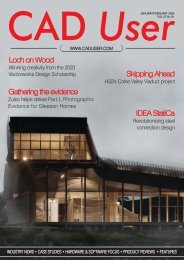DM1907
Create successful ePaper yourself
Turn your PDF publications into a flip-book with our unique Google optimized e-Paper software.
Dm TECHNOLOGY FOCUS: PAPER HANDLING<br />
Hard to handle?<br />
In a perfect world, every scan job would involve<br />
neatly stacked batches of the same size and weight<br />
paper, but in reality organisations handle a wide<br />
variety of document types every day. Petra Beck,<br />
Market and Business Intelligence Manager at Alaris,<br />
explains how to take advantage of advanced paper<br />
handling technologies<br />
Document capture is the critical first<br />
step for automating paper-based<br />
business processes. Scanners that<br />
offer advanced paper handling capabilities<br />
in addition to fast and efficient image<br />
processing significantly reduce the time<br />
spent digitising documents. Many<br />
organisations overlook the bottlenecks<br />
related to paper handling that slow down<br />
the capture process. Removing unnecessary<br />
manual steps when preparing documents is<br />
critical to saving time and money, and<br />
ensures valuable information flows<br />
seamlessly into business systems.<br />
BE PREPARED<br />
One of the most time-consuming elements<br />
of digitisation is document preparation - it's<br />
the first and most important step in a<br />
batch scanning process. Half of the staff<br />
involved in most scanning operations are<br />
dedicated to document preparation. This<br />
can include removing paper clips, staples<br />
and other binding materials; checking to<br />
ensure all edges are unfolded; and<br />
inspecting for tears or other damage to<br />
pages. There is also a requirement to presort<br />
papers that may cause problems<br />
during the scanning process.<br />
When scanners can't handle documents of<br />
mixed shapes and sizes, staff have to spend<br />
significant time to pre-sort or add steps like<br />
gluing smaller documents onto A4/letter<br />
sheets or cutting longer documents to align<br />
with A4 documents. Pre-sorting is also a<br />
workaround to address instances where<br />
scanners fail to deliver consistent output<br />
when processing documents with mixedquality<br />
colour and contrast.<br />
Digitisation often starts in the mailroom:<br />
incoming mail has to be dealt with<br />
efficiently on a daily basis and staff often<br />
have time-sensitive targets to scan<br />
documents and make them available for<br />
processing by a certain time of day. Where<br />
scanning is outsourced, BPOs and Scan<br />
Service Providers have to meet customer<br />
SLAs. Even in lower volume client-facing<br />
scanning applications, paper feeding issues<br />
can occur, resulting in a frustrated clerk and<br />
an unhappy customer.<br />
DOCUMENTS AREN'T PERFECT<br />
Organisations handle a wide variety of<br />
document types every day - including<br />
A4/letter, A3/tabloid and larger or longer<br />
format documents, envelopes, postcards,<br />
checks, vouchers and ID cards. The majority<br />
of production scanning applications involve<br />
batches of mixed and paper quality.<br />
Documents rarely arrive in perfect<br />
condition. They are folded, corners bent or<br />
torn, and may be wrinkled, lightweight or<br />
fragile. Documents may have photographs<br />
glued on, post-it notes attached, or be<br />
bound together by staples or paper-clips.<br />
The mix and condition of documents to<br />
be scanned thus helps define the paper<br />
handling requirements of the scanner used<br />
for the project.<br />
ON THE WAY OUT<br />
It's also important to consider what<br />
happens to documents after scanning.<br />
This determines the requirements for<br />
output stacking.<br />
Scenario 1: Paper documents will be put<br />
back into folders after scanning so original<br />
order must be maintained.<br />
Scenario 2: Paper documents will be stored<br />
in boxes for archival purposes so order is<br />
not always critical. However, when retaining<br />
original order is imperative, image<br />
addressing permits sequential numbers to<br />
be applied to each scanned document and<br />
each batch to be accurately tracked using<br />
patch codes.<br />
Scenario 3: Paper documents will be<br />
destroyed after scanning so the document<br />
output order is not important.<br />
Alaris research suggests that more than<br />
48% of low volume production scanning<br />
applications fall into Scenario 1, thus the<br />
order of documents is critically important.<br />
Making the right technology choices at the<br />
24<br />
@DMMagAndAwards<br />
July/August 2019<br />
www.document-manager.com

















